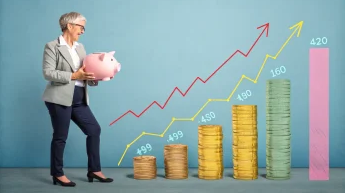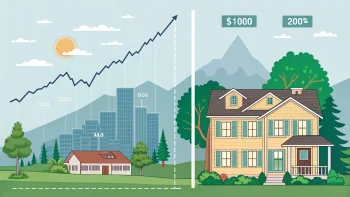In a rising interest rate environment – with rate increases predicted over successive Fed meetings – retirees with fixed-rate portfolios are in a quandary: Should they renew their upcoming Certificates of Deposits (CD) maturities at the prevailing rate; or should they hold off until the next rate hike announcement? Renew now and, if rates do rise, rue that renewal decision. Hold off too long, and if rates decline a notch, regret the decision to not renew when you had the chance!
This article will talk about a laddering strategy that allows fixed-rate portfolios to get the best of both worlds; while also benefiting from higher overall rates of returns.
Table of Contents
ToggleLaddering 101 – Into the Weeds
Typically, the longer an investments’ maturity term, the higher the interest rate it commands. For instance, if locking-in an investment for one year gets you 2% interest, a 5-year term investment might yield 4% or even 5%. CD Laddering is a passive income-generating investing strategy that allows retirees, or fixed-income investors, to use CD’s of varying lengths in maturity, to benefit from a spectrum of interest rates. Specifically, here’s how the ladder works:
Assume you have a total of $10,000 to invest in your CD portfolio.
INITIAL INVESTMENT
You’d break that amount into five equal tranches (of $2,000 each), and here’s how you would initially invest each slice of that pie:
- $2,000 – 1-year term (assume a rate of 2.26%)
- $2,000 – 2-year term (@ 2.86%)
- $2,000 – 3-year term (@ 3.25%)
- $2,000 – 4-year term (@ 3.30%)
- $2,000 – 5-year term (@ 3.75%)
When you’re done, you’ll have $2,000, plus interest earned, maturing each period, from one to five years.
As you will appreciate from the graphics above, the red lines have formed a neat- looking step-shaped pattern – hence the term “ladder”.
RENEWAL
When it comes to managing the renewal of your CD ladder, investors have a choice of options to consider, depending on what the prevailing interest rate environment is.
Automatic Renewals
Most CD providers offer an automatic renewal option, which seamlessly renews the maturing CD for the same term as the original one. So, when your 1-year product matures, if you’ve chosen the auto renewal option, the issuer will renew it for a further 1- year, at the then prevailing interest rate. Typically, all other features of the CD remain the same (Type of CD, Interest Compounding choice, Interest Payout choice).
If monitoring and managing your CD portfolio is a “hassle” for you, then this is likely the best choice. However, automatic renewals have a downside, in that it takes away your ability to move money into a different maturity term, with a more favorable rate, if the option presents itself at maturity.
5-Year Renewals
Another strategy is to renew each matured CD to a 5-year term – regardless of what the initial term was. So, upon maturity of your 1-year CD, you’ll renew it for a further 5-years; as you’ll do for the 2-year, 3-year, 4-year and 5-year CDs, as they each complete their initial investment term. The resulting portfolio will resemble maturities of various lengths, as illustrated in the next graphic.
Visually, if you focus on the gold-shaded region of the graphic, you can see that, with each successive wave of renewals, the “ladder” maintains its shape. Here’s why:
- 5-year rung: After you renew the 1-Year CD to a 5-year product, you now have a CD that matures in 5-years (year 2 to 6)
- 4-year rung: Your original 5-year product now has 4-years left to maturity (year 2 to 5)
- 3-year rung: The 4-year CD has 3-years left before it matures (year 2 to 4)
- 2-year rung: The 3-year CD has 2-years to maturity; and finally (year 2 to 3)
- 1-year rung: The 2-year CD expires in 1-year (year 2)
So, by doing 5-year renewals of each initial term, as they mature, you’ll maintain your ladder, and have a constant portfolio of CD’s that mature in 1-to-5-year durations. Because you now have in place the built-in mechanics to maintain the ladder, putting this strategy on auto-pilot (auto renewal) might be an option to consider. However, as indicated earlier, you risk automatically renewing at unfavorable rates, especially in a rising rate environment.
What retirees and fixed-rate investors must realize, however, is that – though we have structured our example that way – longer-duration CDs don’t necessarily come with higher rates. For example, some financial institutions seeking short-term liquidity may tempt savers to lock in shorter-duration CDs at relatively higher rates, than their competitors’ higher-rate, longer-duration products.
What’s your Poison: Types of CDs
CD laddering isn’t a one-size-fits all strategy. There are a variety of CDs available to retirees and investors, to create innovative ladders, and each has their own set of features and characteristics. What’s good for one investor, may not be good for another. Here are six types of popular CDs that are available today:
TRADITIONAL CD
This is the most common type of product available at all CD issuers. You buy a CD, of at least the minimum value, for a specified term, and at the designated rate (Annual Percentage Yield – APY). Upon maturity, unless you opted otherwise (more on this later – pay interest at each anniversary vs. compound it) the issuer will return your principal amount along with interest earned.
If you opted for automatic renewal, the accumulated amount (principal + interest) will be rolled-over into another term mirroring that of the original purchase. Before using this type of a product to construct a ladder, beware that some traditional CDs come with stiff early withdrawal penalties that may significantly diminish your total returns.
STEP-UP CD
With this type of product, the issuer automatically “steps up” the interest rate at pre- determined (fixed) intervals, over the holding duration. For instance, on a 3-year Step- up CD, the initial rate offered might be 0.05% during the first year, then stepping up to 0.10% for the next year, and then to 0.15% in the final year.
Sounds great, doesn’t it? Well, if you review the fine print for these products, you’ll see that the blended (or composite) APY you receive at the end of the term is just 0.10% (0.05 + 0.10 + 0.15 divided by 3). Typically, Step-up CDs come with an initial interest rate that’s significantly lower than a comparable traditional CD. Depending on the interest rates offered, you might be better off investing in a 3-year traditional CD instead.
BUMP-UP CD
Like a Step-up product, a Bump-up CD also presents the opportunity to benefit from interest rates that are higher than the initial rate (when you purchased the product). The difference, however, is that you don’t automatically get those increased rates – you must ask for them. Depending on the product issuer, you have a specified number of “asks” – the shorter the duration, the fewer the “asks”.
So, if your CD terms has 1 “ask” for a 3-year Bump-up CD, and interest rates rise three times during that period, you only get one chance to request a rate increase. Typically, Bump-up CDs come with an initial interest rate that’s in-line with comparable traditional CDs.
LIQUID CD
These are called “liquid” because their features include a no-penalty, cashable element that most Traditional CDs lack. It means that, if you withdraw your investment part-way into maturity, you won’t have to pay a fee. The issuer will pay you back your principal, plus accumulated interest as of the date of withdrawal. Because they offer liquidity to investors, these CDs typically come with a lower APY than Traditional CDs.
If a key requirement of your ladder-building strategy is to have funds available relatively quickly, then Liquid CDs may be a good product to add to a retirees’ fixed income portfolio. Additionally, they make a good investment in a rising rate environment, where you can prematurely withdraw your lower rate-bearing CD, and invest the proceeds in a higher-APY product.
CALLABLE CD
This is an inverse product to the Liquid CD, and gives issuers the option to “call back” your CD within a specified period, prior to the maturity date. Because the “call” is at the discretion of the issuer, that decision must factor into the mix when building your ladder – a rung of your ladder might be pulled away when you least expect it!
They (the issuers) may do so in a falling rate environment, where they have dropped the rate on new CDs of the same duration. So, if you have a 5-year CD with a 3.75% APY, and rates have dropped for new 5-year terms, the issuer may call back your CD after one year.
On a $10,000, 5-year CD, this means they pay you 3.75% ($375) for just one year. You lose the opportunity to earn a further $1,646 on your original investment. Now, if the issuer offers you a 4-year product at 3.30% APY, and you decide to take it, you’ll earn a total of $1,439 over a four-year term. This brings the earnings from your total 5-year investment ($10,000 @ 3.75% for one year, plus $10,375 @ 3.30% for four years) to $1,814 ($375 + $1,439). You lose a total of $207 ($2,021 minus $1,814) if the issuer calls back your initial investment after one year.
In this scenario, you’re also left trying to figure out what to do with a prematurely called- up investment, because the reinvested funds might destabilize your otherwise well- thought-out ladder: In the above example, when you reinvest in an unplanned 4-year term, you might end up with an extraordinarily larger 4-year rung than you had originally anticipated.
ZERO-COUPON CD
This type of CD might appeal to retirees and investors who aren’t concerned about receiving regular interest payments on their deposits. Essentially, the mechanics entail paying below face value (e.g., paying $30,000 on a $40,500 face value, 10-year CD) upfront, with the certainty of receiving the face value upon maturity. The matured value reflects principal and interest repayments.
The issue with these products is that they’re typically offered for relatively longer durations. Additionally, they may not be tax efficient for retirees because, even though you don’t receive interest each year, you must declare the interest earned for the year at tax time – and pay taxes.
As you can appreciate, there are a broad array of CD’s to help you build a ladder. At the end of the day, which products you choose, and at what terms, depends on your investing objectives.
Building Blocks for Your CD Ladder: Things to be aware of
Always understand how your ladder will grow, and read the fine print before deciding on a building block for your CD ladder. Specifically, pay attention to the following aspects of a CD ladder:
COMPOUNDING FREQUENCY
When selecting a CD product for your ladder, the rule of thumb is: The longer you invest, the higher your returns. That’s because longer-duration CDs have more time to benefit from the power of compounding. However, when you invest in a CD for a specific term – say, 5-years – it doesn’t automatically mean you’ll benefit from only five compounding cycles.
Look for verbiage such as “Interest is calculated daily and compounded annually”; or “…calculated monthly and compounded quarterly.” In general, the more the number of compounding periods, the higher your returns will be. In the above graphic, 12- compounding cycles (monthly: 12 x 5 = 60 over 5-years) yield interest of $4,773.57, on a $25,000 5-year CD @ 3.50% APY. However, that same CD yields only $4,692.16 interest with yearly (1 x 5 = 5) compounding.
PAYING-OUT INTEREST
For most retirees, CDs are a source of “guaranteed” income. However, whether you decide to re-invest that interest, or cash it out and use it for your living expenses, determines how your nest egg grows. If you opt to have your interest paid out to you at each payment date, your CD portfolio is “static” – at the end of each maturity, you’ll only receive your principal back, since you’ve been collecting interest at each interest payment anniversary.
Opting for interest payout, rather than compounding it, is the same as receiving simple interest on your CD for the entire duration of its term. In the above graphic, an “interest paid out” strategy yields $2,250 in total payments over 5-years – that’s a 22.50% total return ($2,250 divided by $10,000 multiplied by 100). In contrast, letting the interest compound yields a total return of 24.62%.
GUARANTEEING SAFETY OF YOUR INVESTMENTS
To ensure your CD ladder is safe, make sure you hold those investments only in Federal Deposit Insurance Corporation (FDIC) insured institutions – such as most major banks. In the event that a bank goes bust (declares bankruptcy), the FDIC ensures CD holders recoup their balance – up to $250,000 per insured institution.
Some CD brokers offer higher interest rates to tempt depositors to buy their products. If this is not a FDIC-insured institution, retirees should exercise caution before investing money without ensuring the security of your transaction. Also, if your CD balances are larger than $250,000, you should consider building those ladders in multiple insured institutions.
Summing it Up
With limited steady retirement income streams at their disposal, retirees typically turn to fixed income investing to guarantee a passive flow of funds to maintain their retirement lifestyles. Fixed income products, like CDs, are a prime vehicle for fixed-income investors. However, instead of just buying CDs of any duration, as and when investible funds become available, retirees should consider a laddered approach to CD investing. This strategy ensures that you will not tie-up all your capital into longer duration products. It also provides investors the opportunity to benefit from rising rates, and provides protection in falling rate environments.
















